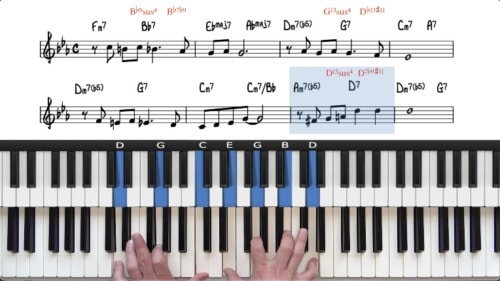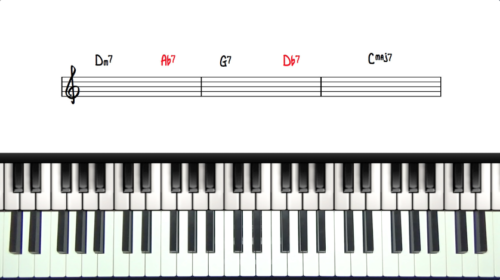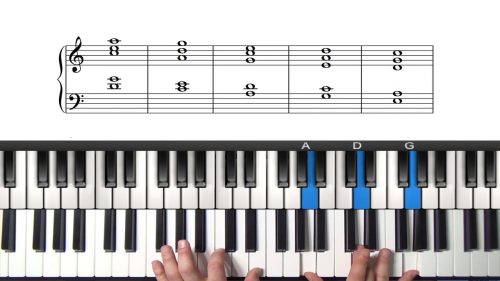“Pure Imagination” Tutorial
Welcome to this tutorial on the tune “Pure Imagination” from the movie Willy Wonka and the Chocolate Factory.
In this lesson we create a full solo piano arrangement which incorporates jazz theory from throughout the PianoGroove syllabus. In particular, we focus on chord substitutions and reharmonisations to enrich the harmony of the tune.
Related Theory Lessons
The following theory areas have been covered in detail in other lessons, click the links below if you would like to learn more about these topics:
Lesson Downloads
-
Pure Imagination Midi File File Type: midi
Practice Tips
-
If some of the voicings are too big to reach, remember that we can always rearrange the notes of our voicings into a smaller register of the piano.
-
Experiment with suspensions in the 251s, sometimes we resolve the suspension over the V7 chord, and other times we move straight to the Imaj7 chord.
-
This arrangement features quartal harmony through the use of So What Voicngs and Pentatonic Voicings. If this theory is new to you, check out the related theory lessons above.
-
Study the #11 ending where we delay the final resolution by landing on a major chord a half step above the final chord. Try adding the #11 colour here for a mysterious and uplifting ending.
-
The harmony starts on the ii-7 chord. We can set this up with a Imaj7 / IV7 / iii-7 / VI7 progression. Run through this progression experimenting with different voicings, colours, alterations, and the tritone substitutes.






Hi Hayden. I can’t get enough of this song already 😀 and the most interesting of all, each time I would practice the first 4-5 songs I have slowly learned – it would give me the same feeling no matter how many gazillion times (i feel) that i have played them. How is that possible? thats probably what makes jazz so different from other genres..
my question is – with the previous songs I’ve learned, and I’m not sure if this is normal in beginner jazz learners like myself – probably because Im still really getting to know very well and slowly building a bank of jazz chords in my head – So when I’ve finished learning to just sight read a song – example My funny valentine, or Embraceable you – I would sometimes end up realising (not all the time) I’ve played one of the notes on my left hand or right hand chord wrong – and that confusion happens when the right hand notes in a chord has for example an Eb while the E maybe on the left hand is not a flat – how do I train myself more to easily detect that kind of mistake in the future? Super thanks in advance.
Pure imagination has a super stunning arrangement and all the flavours of anything beautiful in terms of sound – is just there! Thank you so much for this awe-inspiring lesson!
by the way, will there be a transcription for Pure imagination and audio as well? I always love listening to the audio of your lessons and it keeps my brains wired haha… and helps me to get to know the song much better if I keep listening to it… Super thanks again!
Hi Tina 👋🏻
I’m glad you like the arrangement.
It’s important to understand that we will be playing the jazz standards for the rest of our lives, and with each year that passes we get a deeper understanding of the harmony and the form of these songs. Don’t worry about making the occasional mistake here and there, it’s natural when just starting out.
Also the more tunes that we learn, the more similar we realise they are. The chord progressions of jazz standards follow very similar frameworks and so we often use the same voicings which helps to reinforce our memory and recollection of specific chord shapes.
I can understand that from a classical standpoint, having a sharp/flat in the left hand, and the related natural in the right hand can be a little confusing, however, in jazz this is very common and it’s something that you will become more comfortable over time.
As you progress as a jazz student you will develop more spontaneity in the chords you play. When starting out our harmonic knowledge is not developed to the point where we can make spontaneous decisions on the colours and flavours we add to our voicings. This comes with time Tina and so do be patient with it.
Yes sure thing, I will send you an audio of the lesson via email, and I will be starting on the transcription today.
Talk soon, Hayden
Yay ! Thanks so very much! Hayden. Out of the busy hectic and crazy fun days in school – being a member of Piano Groove really makes life a LOT funner and inspiring everyday. Just the thought that I will be able to learn new songs and concepts about jazz – already makes my day!
Thanks so very much for all the invaluable tips and already have been listening to the track! Stunning performance like always, beautiful arrangement and well detailed lesson – Your playing of the songs is always a hit! Spectacular and feelingful! Take care and stay safe!
Ditto Tina. Hayden did an outstanding job on this tune. I am loving it!
I have always loved this song. Your arrangement is exceptional. Thanks for giving me an opportunity to play my favorite song. I am trying to get better with improvisation. I am beginning to internalize much of the information from your lessons. With your help, I’ll get there. Thanks. You are an excellent instructor.
Hey Carl – I’m glad you enjoyed the lesson and thanks for the kind words.
For improvisation-related lessons, check out my 2 jazz standard courses below which both have an improvisation module:
https://www.pianogroove.com/jazz-piano-lessons/cocktail-improvisation-for-beginners/ https://www.pianogroove.com/jazz-piano-lessons/ballad-voicings-fills-improv/
These courses will teach you some of the essential building blocks of improvised solos which are: chords tones, approach patterns, arpeggios, and other devices.
Also transcribing from your favourite recordings is very important to develop your own personal sound and improvisation style. I explain how to get started with transcription and useful software in this seminar:
https://www.pianogroove.com/live-seminars/how-to-transcribe/
Check out those lessons/seminars and keep me posted on your progress!
Talk soon, Hayden